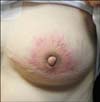Dear Editor:
Although gastric cancer is one of the most common cancers in Korea, cutaneous metastasis is rarely reported, and the reported incidence of cutaneous metastasis of gastric cancer was 0.19% in a single Korean hospital1. In a clinicopathological analysis of 27 patients with cutaneous metastasis of gastric cancer, Kim et al.1 reported that the most common site was the abdomen (33.3%), and the most common clinical finding was a nodular lesion (55.6%), followed by an inflammatory lesion (25.9%). Herein, we report a rare case of cutaneous metastasis of gastric cancer mimicking primary inflammatory breast cancer.
A 55-year-old woman was referred for an erythematous patch with swelling on the left breast for 2 months. She denied any trauma history. Physical examination revealed a diffuse patch with tenderness and a small, round, blue nodule (Fig. 1). There was no other palpable nodule in both the breasts and in the axillae. Fourteen years previously, she had a diagnosis of advanced gastric cancer and underwent distal gastrectomy. Relapse of gastric cancer was diagnosed through peritoneal biopsy 2 years before her presentation to our department, and she then received chemotherapy. Her response to chemotherapy was poor, and when she was referred to our department, a tumor was found to be disseminated in the pleural fluid and peritoneum, as confirmed on peritoneal biopsy and pleural fluid cytology. Ultrasonography, chest computed tomography, and mammography of the left breast showed no definite mass or microcalcification. Histopathological findings showed a poorly differentiated carcinoma with prominent lymphovascular invasion. Immunohistochemical examination showed that the cells were positive for carcinoembryonic antigen and cytokeratin (CK)-7 but negative for CK-20, gross cystic disease fluid protein-15 (GCDFP-15), estrogen receptor (ER), and progesterone receptor (PR) (Fig. 2). On the basis of these clinical and histological findings, cutaneous metastasis of gastric cancer was diagnosed. She then received radiotherapy to the left breast.
There are only a few reports on cutaneous metastasis of breast cancer mimicking primary inflammatory breast cancer, and among those cases, seven originated from gastric cancer234. Differential diagnosis of primary and metastatic adenocarcinoma of the breast represents a clinical challenge3. Although some gastric cancers have similar patterns of CK staining, breast adenocarcinoma cells are positive for CK-7 but negative for CK-20. ER, PR, and GCDFP-15 are frequently expressed in primary breast adenocarcinoma, whereas for the absence of all three proteins on staining is specific for gastric adenocarcinoma2. The direct spread of tumor cells through dermal lymphatic vessels could cause inflammatory changes in the skin, which are found in both primary and metastatic inflammatory carcinomas25. In addition, clinical findings of inflammatory breast cancer can lead to misdiagnosis of acute mastitis, especially in patients with no history of malignant disease5. Most reported cases of breast metastasis were found to have nodules that are suggestive of a benign tumor2. However, in our case, there was no definite nodule on radiologic findings, suggesting metastasis. Despite the negative findings on imaging evaluations, dermatologists should be aware of the possibility of breast metastasis, especially in patients with a history of malignant disease.
Figures and Tables
Fig. 2
(A, B) Histopathological findings showed poorly differentiated carcinoma with prominent lymphovascular invasion (H&E; A: ×40, B: ×100). Immunohistochemical examination showed that the cells were positive for carcinoembryonic antigen (CEA) and cytokeratin (CK)-7 (C) but negative for CK-20 (D), GCDFP-15 (E), estrogen receptor (F), and progesterone receptor (G) (C~G: ×100).

References
1. Kim MS, In SG, Won CH, Chang SE, Lee MW, Choi JH, et al. A clinicopathological analysis of cutaneous metastasis from gastric cancer in Korea. Korean J Dermatol. 2010; 48:360–365.
2. Sato T, Muto I, Fushiki M, Hasegawa M, Hasegawa M, Sakai T, et al. Metastatic breast cancer from gastric and ovarian cancer, mimicking inflammatory breast cancer: report of two cases. Breast Cancer. 2008; 15:315–320.

3. Mandato VD, Pirillo D, Gelli MC, Cavina M, La Sala GB. Gastric cancer in a pregnant woman presenting with low back pain and bilateral erythematous breast hypertrophy mimicking primary inflammatory breast carcinoma. Anticancer Res. 2011; 31:681–685.




 PDF
PDF ePub
ePub Citation
Citation Print
Print




 XML Download
XML Download